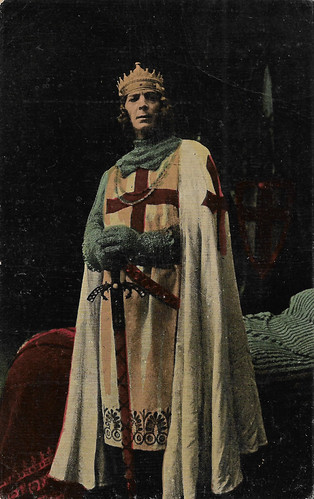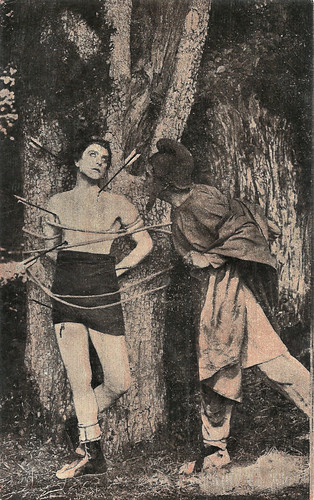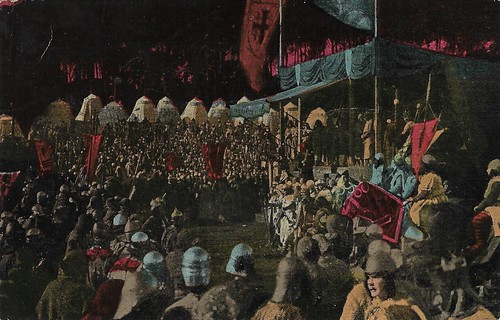
Italian postcard. Photo: Cines. Scene from Quo vadis? (Enrico Guazzoni, 1913), adapted from the novel by Henryk Sienkiewicz. Caption: The Christians were exposed to the beasts at the circus.

Spanish collector card by Chocolate Pi, Barcelona, no. 8. Photo: Distr. J. Pich, Barcelona / Cines. Leda Gys in Amica (Enrico Guazzoni, 1916).

Italian postcard by IPA CT Duplex / Uff. Rev. St. Terni, no. 3279. Photo: Film Cines. Ruggero Barni as Jean Guery in Madame Tallien / Madame Guillotine (Mario Caserini, Enrico Guazzoni, 1916), based on the play by Victorien Sardou set during the French Revolution. Caption: The last cart. Guery is saved.

Spanish postcard for Amatller Marca Luna chocolate, series 8, no. 14. Photo: Palatino Film. Livio Pavanelli as St. Sebastiano in Fabiola (Enrico Guazzoni, 1918), hosting the blind Christian refugee Cecilia (Valeria Sanfilippo) on the request of the young Pancrazio (unknown).

Spanish cromo (collector card) by Chocolat Imperiale, no. 5 of 6 cards. Amleto Novelli as Tancredi in the Italian silent period piece La Gerusalemme liberata / Jerusalem Liberated (Enrico Guazzoni, 1918), an adaptation of the classic poem by Torquato Tasso.

Italian postcard by Ed. A. Traldi, Milano, no. 738. Rina De Liguoro dies in the final scene of Messalina (Enrico Guazzoni, 1924).
Catapulted to world fame
Enrico Guazzoni was born in 1876 in Rome, Lazio, Italy. He was the son of Bartolomeo Guazzoni and Ginevra, née Santucci. Enrico studied painting at the Accademia delle Belle Arti (Fine Arts Academy) in his native Rome, but did not finish his studies. Guazzoni began his career as a poster artist and set designer for the Alberini & Santoni company in Rome. He was already an appreciated Roman painter when Filoteo Alberini entrusted him in 1907 with the decoration of the ceiling of the Cinema Moderno in Rome, a few years after the cinema opened. Guazzoni carried out the job together with Federico Ballester.
In 1905, Filoteo Alberini founded Cines, which became the leading Italian film company of the time. Guazzoni continued to collaborate with Alberini, designing colourful film posters for Cines. He also acted as a consultant for the sets of films with a historical background. Soon, he permanently joined Cines. Originally, he worked as a set designer for Mario Caserini, but in 1909, he became one of the company's directors.
Soon, Enrico Guazzoni became Cines's most prolific and high-profile director. He made short films in a wide variety of genres. In 1910, he directed Faust, Giulia Colonna, and Adriana di Berteaux. He especially liked costume films set in Roman times, such as Agrippina (1911) and Bruto / Brutus (1911) starring Amleto Novelli. A great success was La Gerusalemme liberata / Jerusalem Liberated (1911), of which he shot another version seven years later. His films demonstrated a real flair for the spectacular and consistently created a strong sense of three-dimensional space absent from earlier films of the genre.
The moderate acclaim won by Guazzoni's early films was paled by the overwhelming international success of Quo vadis? (1913), based on the popular novel by Henryk Sienkiewicz. With 5,000 extras, lavish sets, and a lengthy running time of two hours, the film set the standard for 'Superspectacles' of 'Colossals' for decades to come. This grand historical epic catapulted Guazzoni to world fame. It set the benchmark for epic spectacle before D.W. Griffith and Hollywood cornered the market. Guazzoni lifted that benchmark himself a year later with the colossal - and colossally budgeted - Giulio Cesare / Julius Caesar (1914), a film that required not only the accurate miniature reconstruction of the entire city of Rome but also the employment of 20,000 extras for the crowd scenes.
Guazzoni doubled as art director on his films and used his painting studio to create the sets and costumes. In 1914, he opened his own typography studio in Rome under the name ‘Stabilimento Litografico Enrico Guazzoni’, located in Via Chieti, near Porta San Giovanni. Here he worked as a poster artist, set up a centre for the publication of works by the best painters of the time and, above all, produced posters for the cinema. His collaborators included Tito Corbella, Anselmo Ballester - the son of Federico Ballester, Duilio Cambellotti and Luigi Martinati.

Allegory of Light & Triumph of Photography, ceiling of Cinema Moderno (1904), Rome, Italy. Painted by Federico Ballester and Enrico Guazzoni. Photo: Ivo Blom.

Detail of the ceiling of Cinema Moderno, Rome, Italy - Signature. Photo: Ivo Blom. The original (restored) ceiling from the Cinema Moderno can still be seen in Sala 4 of the Space Roma Moderno in Piazza della Repubblica, Rome. The ceiling represents the Triumph of Photography and was painted by Enrico Guazzoni and Federico Ballester, the father of film poster designer Anselmo Ballester. Their names are visible on the bottom side. Allegorical characters representing the four continents, America, Africa, Europe and Asia bring homage to Photography. In the corners of the ceiling, the heads of Della Porta, Daguerre, Niepce and Talbot are visible (not in these pictures). Moderno was built in 1904 by film pioneer Filoteo Alberini, who founded the Cines film company in 1905. It has been claimed to be the first purpose-built cinema in Italy.

Italian postcard by Uff.Rev. St. Terni. Bruto Castellani and Amleto Novelli in Quo vadis? (Enrico Guazzoni, 1913). Ursus (Bruto Castellani) and Vinicius (Amleto Novelli) implore the audience and Emperor Nero to grace the Christian Lygia (Lea Giunchi) after Ursus has killed the bull on whose back Lygia had been bound. The audience raves because of Ursus' tour de force. Vinicius has stripped his clothes to show his scars from the wars, while Ursus holds up Lygia. All around Nero hold their thumbs up for grace, even if this sign seems to have been a 19th-century invention and is historically incorrect.

Italian postcard. Photo: Cines. Giuseppe Gambardella in Quo vadis? (Enrico Guazzoni, 1913). Caption: A banquet on the Palatine. The fat and drunken man in front is Giuseppe Gambardella, who was also famous as Checco in short Italian comedies.

Austrian postcard by B.K.W.I. (Brüder Kohn, Wien), no. 34. Photo: Cines. Gianna Terribili Gonzales as Cleopatra, enjoying herself in Marcantonio e Cleopatra / Antony and Cleopatra (Enrico Guazzoni, 1913). German film title: Die Herrin des Nils.

Austrian postcard by B.K.W.I. (Brüder Kohn, Wien), no. 35. Photo: Cines. Marc Anthony (Amleto Novelli), dressed as an Egyptian pharaoh, rejects his wife Octavia (Elsa Lenard) in Marcantonio e Cleopatra / Antony and Cleopatra (Enrico Guazzoni, 1913). German film title: Die Herrin des Nils.

Spanish collector card by Reclam Films, Mallorca, no. 12 of 12. Photo: Cines. Scene from Giulio Cesare / Julius Caesar (Enrico Guazzoni, 1914), released in Spain as Julio César. The corpse of Julius Caesar (Amleto Novelli) after his assassination in the Senate. Mark Antony (Orlando Ricci) swearing revenge.

Spanish collector card by Chocolate Pi, Barcelona, no. 6. Photo: Distr. J. Pich, Barcelona / Cines. Leda Gys in Amica (Enrico Guazzoni, 1916).

Spanish collector card by Chocolate Pi, Barcelona, no. 9. Photo: Distr. J. Pich, Barcelona / Cines. Leda Gys and Augusto Poggioli in Amica (Enrico Guazzoni, 1916).

French postcard by J. Mayer, graveur, Paris. Photo: Films Primior, Paris / Cines. Alberto Pasquali as Jesus Christ in Christus / Christ (Giulio Antamoro, Enrico Guazzon, 1916). On Palm Sunday, the Sunday before Easter, Christians celebrate Christ's triumphant entry into Jerusalem. In 1915-1916, so right in the middle of the First World War, Italian director Count Giulio Antamoro (1877-1945) went to Palestine and Egypt, on behalf of the film company Cines. Antamoro wanted to film the life of Christ on location. Christus, released in 1916, was a worldwide success, not only because of the quotations of famous artworks such as Fra Angelico's 'Annunciation', Leonardo's 'Last Supper' and Michelangelo's 'Pietà, but also because of the shots on location. When the additional shooting was necessary in 1916, Enrico Guazzoni did this, as Antamoro wasn't available anymore.

French postcard by J. Mayer, graveur, Paris. Photo: Films Primior, Paris / Cines. Alberto Pasquali as Jesus Christ and Leda Gys as Mary in Christus / Christ (Giulio Antamoro, Enrico Guazzon, 1916). The Pietà with Jesus.
His most spectacular film
Enrico Guazzoni's later works, such as the Napoleonic Scuola d'eroi / How Heroes are Made (1914), and Madame Tallien / Madame Guillotine (1916) starring Lyda Borelli, also belong to this new ‘genre’ of films, only later defined as 'Colossal'.
Having set up his own production company in 1918, he continued to produce large-canvas films such as the medieval epic Gerusalemme Liberata / Jerusalem Liberated (1918), adapted from Torquato Tasso's poem, Fabiola (1918) and Il sacco di Roma / The Sack of Rome (1920) directed together with Giulio Aristide Sartorio. The company soon collapsed in the general crisis that gripped the industry in the early 1920s.
In 1923, again for the Cines, Guazzoni directed what many regard as his most spectacular film, Messalina (1924), starring diva Rina De Liguoro as the third wife of Roman emperor Claudius. The film raised the sword-and-sandal epic to new heights and included a splendid chariot race that would be closely imitated, two years later, in the Hollywood production of Ben-Hur (Fred Niblo, 1925).
Nevertheless, the cost of Messalina helped to bankrupt the company, and Guazzoni left the industry to return only briefly in the 1930s with a small number of lighthearted and humorous films, the best known being the historical comedy Il re Burlone / The Joker King (1935).
Enrico Guazzoni remained active until 1943. His last work was, of course, a costume film, La Fornarina / The Baker's Girl (1943). Despite the casting of Lída Baarová and Anneliese Uhlig, the film was only a pale reverberation of the silent Colossals of which Guazzoni had been the absolute star director. He died in 1949 in Rome, Lazio, Italy. He was married to the actress Evelina Paoli.

Italian postcard by IPA CT Duplex. Photo: Cines. Renzo Fabiani as Robespierre and Amleto Novelli as Tallien in Madame Tallien / Madame Guillotine (Enrico Guazzoni, 1916), based on the play by Victorien Sardou. Caption: The Hall of the Convention. Robespierre shouts: President of the assassins, pass me the word!

Italian postcard by IPA CT Duplex, no. 3271. Photo: Films Cines. Lyda Borelli as Terese de Fontenay / Madame Tallien in Madame Tallien / Madame Guillotine (Enrico Guazzoni, 1916). Caption: Liberation of the detained and Tallien.

Spanish postcard for Amatller Marca Luna chocolate, series 8, no. 5. Photo: Palatino Film. Elena Sangro as Fabiola and Signora Poletti as her niece Agnese in Fabiola (Enrico Guazzoni, 1918). When the persecution of the Christians in Rome became too rough, Fabiola took her niece Agnese to her villa in the countryside.

Spanish postcard for Amatller Marca Luna chocolate, series 8, no. 16. Photo: Palatino Film. Livio Pavanelli as St. Sebastiano and Amleto Novelli as Fulvio in Fabiola (Enrico Guazzoni, 1918).

Spanish cromo (collector card) by Chocolate Imperial, no. 2 of 6. The attack on Jerusalem in the Italian silent period piece La Gerusalemme liberata /Jerusalem Liberated (Enrico Guazzoni, 1918), an adaptation of the classic poem by Torquato Tasso.

Spanish cromo (collector card) by Chocolate Imperial, no. 3 of 6 cards. The Crusaders' camp in La Gerusalemme liberata /Jerusalem Liberated (Enrico Guazzoni, 1918), an adaptation of the classic poem by Torquato Tasso.

Italian postcard by Ed. A. Traldi, Milano, no. 738. Rina De Liguoro as the seductive Roman Empress Messalina in Messalina (Enrico Guazzoni, 1924).

Italian postcard by B&G, B, no. 11. Rina De Liguoro as the title character in Messalina (Enrico Guazzoni, 1924). Signed by Rina De Liguoro.

Italian postcard by ASER (A. Scarmiglia Edizioni Roma), no. 159. Carla Candiani in Il leone di Damasco / The Lion of Damascus (Corrado d'Errico, Enrico Guazzoni, 1942).

Italian postcard by Ed. Vecchioni & Guadagno, Roma. Photo: Mediterranea Film / Distribuzione EIA. Anneliese Uhlig and Walter Lazzaro in La Fornarina / The Baker's Girl (Corrado D'Errico, Enrico Guazzoni, 1944), a Spanish-Italian biopic on the Italian artist Raffaello Sanzio/ Raphael, with Walter Lazzaro as Raphael and Lída Baarová as his model and lover Margherita, the inspiration for his painting La Fornarina as well as some Madonnas. Yet, this raises the jealousy of the aristocratic Eleonora d'Este (Anneliese Uhlig), who has Margherita kidnapped. Caption: The art and life of Raphael in the light of a great love. The back of the card contains an ink stamp of the Supercinema Orfeo in Parma, Italy.

Italian postcard. Photo: Medierranea Film / Distribuzione EIA. Loredana as Maria da Bibbiena in La Fornarina / The Baker's Girl (Enrico Guazzoni, 1944).
Sources: Ivo Blom (Quo vadis?, Cabiria and the 'Archeologists'), Alberto Mira (Historical Dictionary of Italian Cinema), Treccani (Italian), Wikipedia (English and Italian) and IMDb.
No comments:
Post a Comment